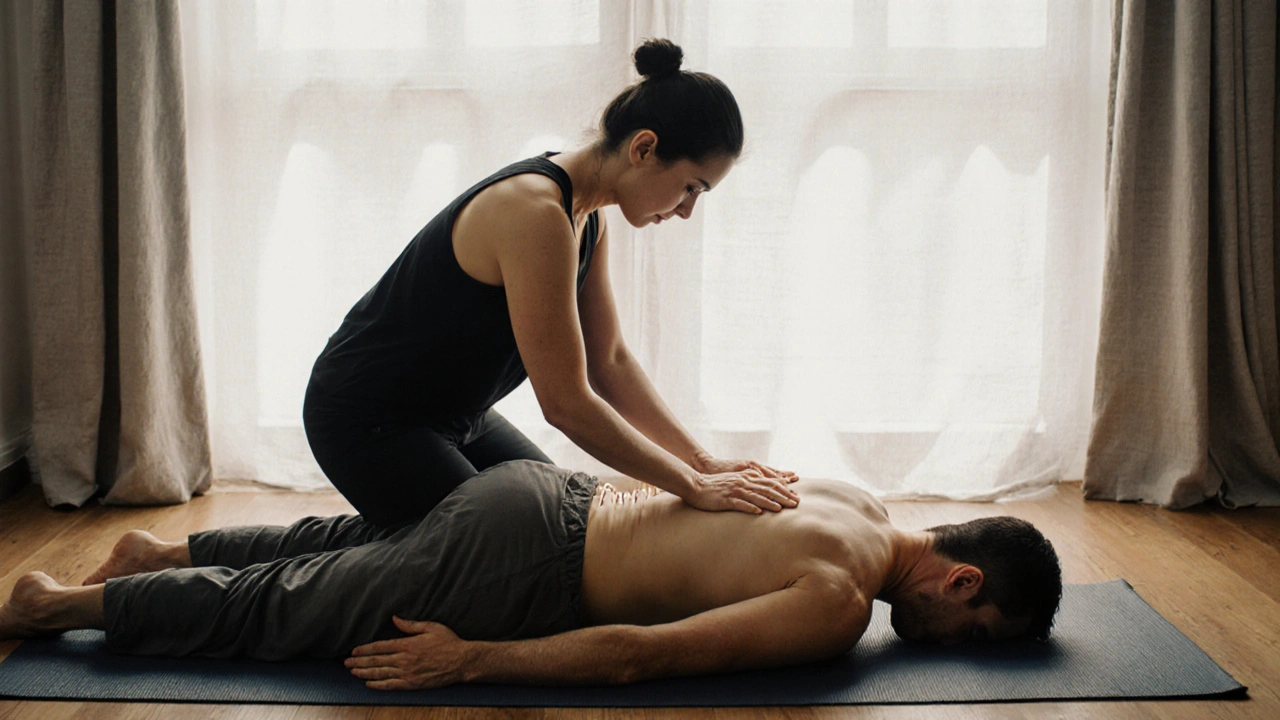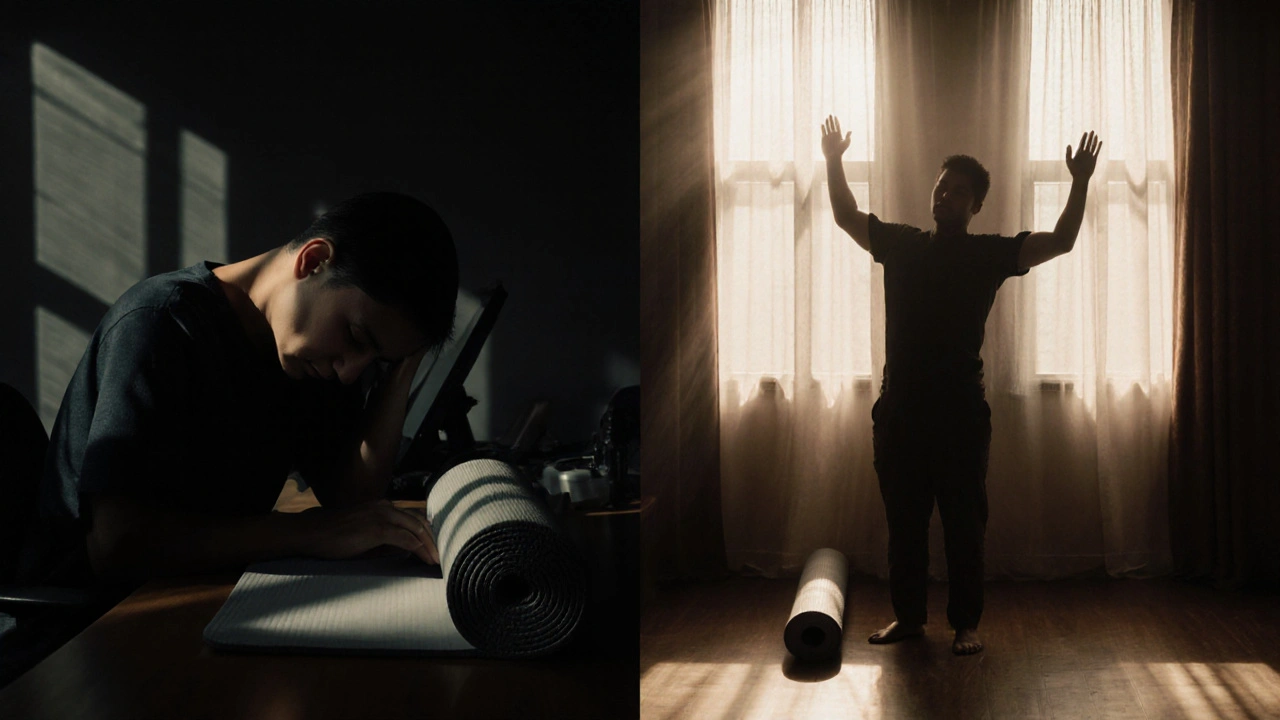Why You Need a Thai Massage in Your Life Today

You know that feeling when your shoulders are locked up, your neck feels like it’s holding a brick, and your brain won’t shut off even though you’ve been in bed for hours? Yeah. That’s not just stress. That’s your body screaming for a reset. And what if the answer isn’t another coffee, another scroll, or another 10-minute stretch? What if it’s a Thai massage?
Not the kind where you lie still and get oiled up. Not the silent, spa-style Swedish rub. This is Thai massage-a live, dynamic, full-body experience that feels like yoga, deep tissue work, and a hug from your most patient friend all rolled into one. And yes, you need it in your life today.
What Exactly Is Thai Massage?
Thai massage isn’t just a technique. It’s a tradition. Originating over 2,500 years ago in Thailand, it was developed by Buddhist monks who blended ancient Indian Ayurvedic principles with yoga, acupressure, and energy line work. They didn’t just want to ease sore muscles-they wanted to restore balance to the whole body.
Unlike other massages where you lie on a table, Thai massage happens on a mat on the floor. You stay fully clothed-comfortable, loose clothes, no oils. The therapist uses their hands, thumbs, elbows, knees, and even feet to apply pressure along energy lines called sen lines. They’ll gently stretch you, twist your limbs, and guide you through positions you didn’t know you could do.
Think of it like this: if a regular massage is a quiet conversation, Thai massage is a dance. It’s active. It’s immersive. And by the end, you’re not just relaxed-you’re reset.
Why Thai Massage Works When Nothing Else Does
Let’s be real. You’ve tried foam rollers. You’ve done yoga videos. You’ve even bought those expensive neck massagers. But the tightness keeps coming back. Why?
Because most pain isn’t just in the muscle. It’s in the connective tissue, the fascia, the nervous system. Thai massage tackles all of it.
Here’s what actually changes after one session:
- Deep tension melts-not just on the surface, but in layers you didn’t know were tight. That knot between your shoulder blades? Gone.
- Mobility improves-you’ll notice you can turn your head easier, reach for the top shelf without wincing, or sit cross-legged without your hips screaming.
- Stress drops fast-one study from the University of Wisconsin found Thai massage lowered cortisol (the stress hormone) by 43% after just one hour. That’s more than meditation, more than a walk, and way faster than a weekend getaway.
- Energy flows-you don’t just feel relaxed. You feel awake. Lighter. Like you’ve been unplugged from a dead battery and plugged back in.
One client in Amsterdam told me: “I used to need two days to recover from my office job. After Thai massage, I felt like I’d slept for eight hours-even if I only had two.”
Thai Massage in Amsterdam: What’s Available?
Amsterdam has more than enough places offering Thai massage-but not all are created equal. You’ve got three main types:
- Traditional Thai massage-done on a floor mat, no oils, full-body stretching. This is the real deal. Look for therapists trained in Chiang Mai or Bangkok.
- Thai oil massage-a hybrid. Still uses stretches and pressure, but adds warm oil. Good if you want deeper muscle release without the intensity of traditional.
- Thai massage with aromatherapy-adds essential oils like lemongrass or lavender. Great for calming the mind, but don’t expect the same level of physical release.
Stick with traditional if you want the full effect. The oil versions are nice, but they’re not what you’re here for if you’re asking, “Why do I need this?”
How to Find a Real Thai Massage in Amsterdam
You don’t want some spa that throws “Thai massage” on their menu because it sounds exotic. You want someone who knows the lines, the rhythm, the intent.
Here’s how to spot the real thing:
- Check their training. Ask: “Where did you learn Thai massage?” If they say “online course” or “two-week workshop,” walk away. Look for schools like Wat Po in Bangkok or certified Thai Healing Alliance instructors.
- Watch how they prepare the room. No candles, no soft music, no silk robes. Just a clean mat, maybe a blanket. Authentic Thai massage is about movement, not ambiance.
- Read reviews that mention “stretching,” “pressure,” or “felt like yoga.” If they all say “relaxing” and “calming,” they’re probably doing Swedish with a Thai label.
- Go to neighborhoods like De Pijp, Oud-West, or Jordaan. These areas have smaller, independent studios run by therapists who treat this as a craft-not just another service.
One studio in De Pijp, Thai Roots, has been running since 2017. Their lead therapist trained for three years in Chiang Mai. That’s the kind of detail that matters.

What Happens During a Session? (No Surprises)
First, you’ll sit down for two minutes. No form-filling. No questionnaire. Just a quick chat: “Where do you feel tight?” “Any injuries?” That’s it.
Then you lie on the mat. The therapist starts at your feet. They’ll press into your arches, pull your toes, rotate your ankles. You might groan. That’s normal.
Next, they’ll move up-knees, hips, back. You’ll be twisted gently into a seated twist, pulled into a forward fold, lifted into a bridge. No forcing. Just steady, rhythmic pressure. You’ll feel resistance-and then release. That’s the magic.
Halfway through, you’ll be on your side. They’ll use their forearm along your spine. You’ll think, “How is that even possible?” Then you’ll realize your back hasn’t felt that open in years.
At the end, you’ll sit up. You’ll feel… different. Not sleepy. Not numb. Alert. Calm. Like your body finally caught up with your mind.
How Much Does It Cost in Amsterdam?
Don’t fall for the €25 deals. Thai massage isn’t cheap because it’s labor-intensive. It’s not just hands-it’s body weight, technique, years of training.
Here’s what to expect:
- 60 minutes: €65-€85. This is the sweet spot for most people. Enough time to work through major tension zones.
- 90 minutes: €100-€130. If you’re chronically tight, have a desk job, or just want to go deeper.
- 120 minutes: €150+. Rare. Only for those treating chronic pain or rehab.
Book ahead. Good therapists are booked a week out. Most studios let you book online. Don’t show up walk-in unless you’re willing to wait.
Is Thai Massage Safe for Everyone?
Yes-if you’re honest.
It’s not for people with:
- Recent fractures or bone injuries
- Severe osteoporosis
- Deep vein thrombosis (blood clots)
- Active infections or fever
If you’re pregnant, it’s still safe-but tell your therapist. They’ll adjust positions and avoid deep pressure on the abdomen.
And if you’re not flexible? Perfect. That’s why you’re here. Thai massage isn’t about how far you can bend. It’s about what your body can release.

Thai Massage vs. Swedish Massage: What’s the Difference?
| Feature | Thai Massage | Swedish Massage |
|---|---|---|
| Position | On floor mat, fully clothed | On table, unclothed (under towel) |
| Technique | Stretching, acupressure, joint mobilization | Long strokes, kneading, light pressure |
| Oil Used | No | Yes |
| Intensity | Medium to deep | Light to medium |
| After Effects | Alert, energized, mobile | Relaxed, sleepy, calm |
| Best For | Tightness, stiffness, chronic pain, mobility | Stress relief, light relaxation |
Swedish is great if you want to zone out. Thai massage is for when you want to feel alive again.
Frequently Asked Questions
Can I do Thai massage if I’m not flexible?
Absolutely. Thai massage isn’t about how far you can stretch-it’s about what your body can release. The therapist adjusts every movement to your range. Many people start stiff and leave feeling like they’ve gained inches of mobility.
How often should I get a Thai massage?
Once a month is ideal for maintenance. If you sit at a desk all day, have chronic pain, or deal with high stress, once every two weeks helps. Think of it like brushing your teeth-you wouldn’t wait three months to do it.
Does Thai massage hurt?
It should feel intense, not painful. There’s a difference. You might feel a burn or a deep ache-but if it’s sharp, burning, or makes you gasp in pain, speak up. A good therapist will adjust. The goal is release, not punishment.
What should I wear?
Loose, stretchy clothing. Yoga pants and a t-shirt work best. No jeans, no tight leggings. You’ll be moving, twisting, and stretching-your clothes need to let you.
Can I eat before a session?
Avoid heavy meals two hours before. A light snack is fine. You don’t want to feel bloated while you’re being twisted into a seated forward fold.
Ready to Feel Like Yourself Again?
You don’t need another vacation. You don’t need another app to track your sleep. You don’t need to wait until Monday to feel better.
You need one hour on a mat, with someone who knows how to unlock your body. That’s Thai massage. It’s not a luxury. It’s a repair tool. For your shoulders. For your spine. For your nervous system. For your mind.
Book your session. Not tomorrow. Today. Your body’s been waiting.


